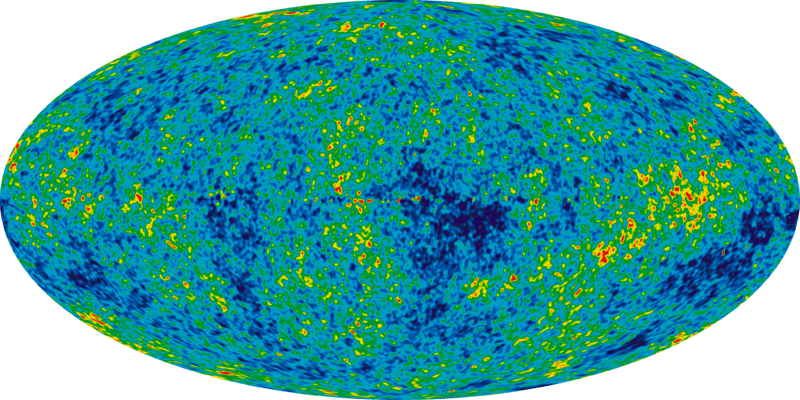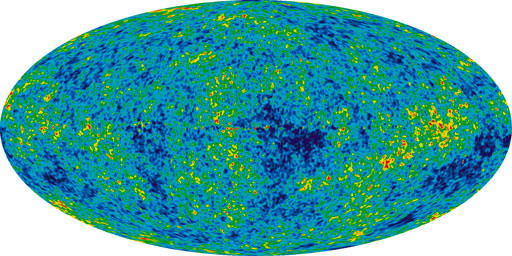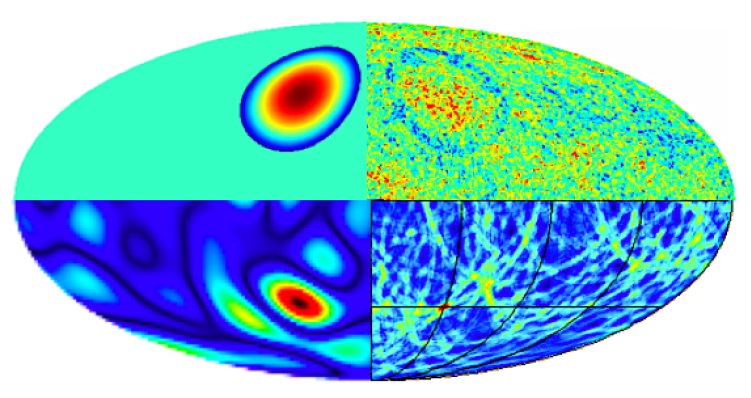Universe Today | Cosmology | 22 Nov 2010
Scientists glimpse universe before the Big BangHave scientists seen evidence of time before the Big Bang, and perhaps a verification of the idea of the cyclical universe? One of the great physicists of our time, Roger Penrose from the University of Oxford, has published a new paper saying that the circular patterns seen in the WMAP mission data on the Cosmic Microwave Background suggest that space and time perhaps did not originate at the Big Bang but that our universe continually cycles through a series of “aeons,” and we have an eternal, cyclical cosmos. His paper also refutes the idea of inflation, a widely accepted theory of a period of very rapid expansion immediately following the Big Bang.
Penrose says that inflation cannot account for the very low entropy state in which the universe was thought to have been created. He and his co-author do not believe that space and time came into existence at the moment of the Big Bang, but instead, that event was just one in a series of many. Each “Big Bang” marked the start of a new aeon, and our universe is just one of many in a cyclical Universe, starting a new universe in place of the one before.
Penrose’s co-author, Vahe Gurzadyan of the Yerevan Physics Institute in Armenia, analyzed seven years’ worth of microwave data from WMAP, as well as data from the BOOMERanG balloon experiment in Antarctica. Penrose and Gurzadyan say they have identified regions in the microwave sky where there are concentric circles showing the radiation’s temperature is markedly smaller than elsewhere.
These circles allow us to “see through” the Big Bang into the aeon that would have existed beforehand. The circles were created when black holes “encountered” or collided with a previous aeon.
PhysOrg | General Physics | 23 Nov 2010
Cosmic rebirthIn general, asking what happened before the Big Bang is not really considered a science question. According to Big Bang theory, time did not even exist before this point roughly 13.7 billion years ago. But now, Oxford University physicist Roger Penrose and Vahe Gurzadyan from the Yerevan Physics Institute in Armenia have found an effect in the cosmic microwave background (CMB) that allows them to "see through" the Big Bang into what came before.
...
The discovery doesn't suggest that there wasn't a Big Bang - rather, it supports the idea that there could have been many of them. The scientists explain that the CMB circles support the possibility that we live in a cyclic universe, in which the end of one “aeon” or universe triggers another Big Bang that starts another aeon, and the process repeats indefinitely. The black hole encounters that caused the circles likely occurred within the later stages of the aeon right before ours, according to the scientists.
Science News | Atom & Cosmos | 26 Nov 2010
Concentric circles in WMAP data may provide evidence of violent pre-Big-Bang activity - VG Gurzadyan, R PenroseMost cosmologists trace the birth of the universe to the Big Bang 13.7 billion years ago. But a new analysis of the relic radiation generated by that explosive event suggests the universe got its start eons earlier and has cycled through myriad episodes of birth and death, with the Big Bang merely the most recent in a series of starting guns.
That startling notion, proposed by theoretical physicist Roger Penrose of the University of Oxford in England and Vahe Gurzadyan of the Yerevan Physics Institute and Yerevan State University in Armenia, goes against the standard theory of cosmology known as inflation.
The researchers base their findings on circular patterns they discovered in the cosmic microwave background, the ubiquitous microwave glow left over from the Big Bang. The circular features indicate that the cosmos itself circles through epochs of endings and beginnings, Penrose and Gurzadyan assert. ...
The circular features are regions where tiny temperature variations in the otherwise uniform microwave background are smaller than average. Those features, Penrose said, cannot be explained by the highly successful inflation theory, which posits that the infant cosmos underwent an enormous growth spurt, ballooning from something on the scale of an atom to the size of a grapefruit during the universe’s first tiny fraction of a second. Inflation would erase such patterns.
- arXiv.org > astro-ph > arXiv:1011.3706 > 16 Nov 2010









